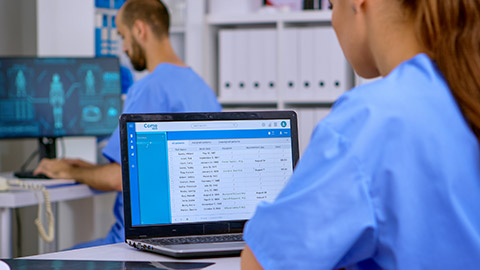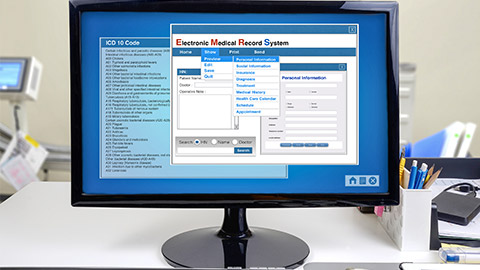In this section you will learn to:
- Identify your own role and responsibilities within the patient recordkeeping system
- Access documented procedures for patient recordkeeping system
- Understand privacy legislations related to patient recordkeeping
- Seek clarification with relevant personnel of unclear procedures
Supplementary materials relevant to this section:
- Reading A: My Health Record
- Reading B: Australian Privacy Principles

As a healthcare worker, one of the main roles you have is to maintain patient records within your organisation. In this section of the module, we will be looking at how you identify and clarify your own role for patient recordkeeping. We will also look at the different legislation and practice standards that you are expected to adhere to when handling patient records.
Before we proceed, you should have a clear understanding of the definition of a patient record and its scope. A patient record includes, but not limited to the following information (Australian Commission on Safety and Quality in Health Care, 2017):
- Personal information - patient’s name, address, date of birth, contact information.
- Medical history - patient’s past and current medical conditions, including allergy information.
- Clinical notes and assessments - patient’s symptoms, diagnosis, treatment plans, pathology test results.
- Medication records - medications prescribed to the patient.
- Consent forms and legal documents - consent forms signed for specific medical procedures and any legal documents such as advanced care directives.
Of course, this list is not exhaustive and depending on the setting you are working in, there may be more information to be included in the patient record. For example, if you work in a mental health clinic, you may need to maintain the patient’s mental health care plan; if you work in a physiotherapy clinic, you may handle the patient’s x-ray results when updating a patient’s record.
Now that you have a better idea of the information included in a patient record, we will look at some specific responsibilities. Some general duties related to handling patient records include accessing patient records, creating and maintaining patient records, follow-up with patient about specific information, and billing and insurance matters. Of course, depending on the size and structure of your team, you may be involved in more or less tasks. Your supervisor or practice manager will inform you of your responsibilities when you commence work, often during induction or training period.
You must have a clear idea of your roles and responsibilities, especially when it comes to maintaining patient records, as it involves handling sensitive and confidential information. It is good practice that when you commence work at a new place, you have a clear idea about your roles and responsibilities and consult your supervisor or senior team members to determine your role and responsibilities.
Most workplaces will also have an organisational policy and procedures manual, which typically documents your responsibilities that are related to maintaining patient records. You should have access to these manuals and documents to familiarise yourself with the relevant procedures. If you are unsure or not provided with these documents, ask your team members or supervisor about it, and request access so you could read and understand them. Otherwise, you should always clarify with your supervisor or team members, if relevant, about your specific tasks. You should not just assume your roles and responsibilities without clarifying and confirming them, as the action or inaction of certain responsibilities can lead to significant consequences for the patient’s health.
Watch
Record Management System

There are several patient record management systems used in different clinical and health care settings. Some systems are specifically used for specific types of care while other systems can be used across all care settings. Some common management systems used are:
- Best Practice - a common electronic medical record system used by many general practitioners.
- Communicare - a patient record management system that is commonly used by community health services.
- Medical Director - a common electronic records management system used by general practitioners.
During your induction or training session, your supervisor should have already told you which management system your workplace uses. They should also run through the basic functions of the system and how to access and maintain patient records with you. As there are too many systems available, it is impossible for us to go through every single system in this Study Guide. Hence, we will be using Halaxy as an example to show you how to maintain patient records, where appropriate. That said, you should always follow your organisation’s procedures to maintain patient records and clarify with your supervisor if you have any questions or doubts.
Apart from the few common management systems listed above, it is crucial that you familiarise yourself with My Health Record. My Health Record is a national electronic health record system used in Australia, which allows patients to access and share a range of health information with healthcare providers. For example, immunisation records, pathology and imaging reports, and specialist letters. It can also be integrated with other patient record management systems that individual healthcare providers use. You may be required to access a patient’s My Health Record to access certain health information or to update key information on it.
Read
Reading A – My Health Record
Most practices are now using an electronic health record system. Take some time to read through this key summary about My Health Record so that you have a good understanding of the system and how it is used and accessed, as you may receive patient query on how to use this system.
Watch

Working in a healthcare environment, you are bound to come across sensitive and personal information, especially when maintaining patient records. With access to patient records, it is vital that you respect patients’ privacy and maintain their confidentiality. This means that you should never disclose a patient’s information outside of the healthcare setting, and the information should be kept between the healthcare professional, the patient, and any relevant administrative staff. If any information has to be released to an external party, this must be done with informed consent provided by the patient. For example, a patient requires a referral to another healthcare provider and provides consent for the relevant information to be shared.
As a healthcare worker, it is important that you understand your responsibility to keep patient information private and confidential. Your workplace would most likely have its own privacy policy that includes how patient information should be handled and maintained to protect the patient's privacy, and you are expected to adhere to it. The policy would also include any consequences of intentional breach of this obligation, including any relevant legal consequences. Other than your organisation’s policy, as a healthcare worker, your role is also bounded by legislation related to patient privacy. We will briefly look at some of pieces of legislation.
Privacy Act 1988
As mentioned, health information is considered to be one of the most sensitive types of personal information, which means how information is handled is highly regulated in Australia. The Privacy Act 1988 (Cth) regulates how private sector organisations, including health services, use, collect, store, and disclose personal information. This also holds the health services responsible for ensuring the patient records are accurate and up to date. Therefore, it is crucial that you familiarise yourself with the Privacy Act 1988 and abide by it to avoid any legal implications. Patients also have the right to know what information is collected about them and how it is being used and disclosed. Patients also have the right to access their health information.
Depending on whether you work in a public or private sector and where you are located, there may be equivalent legislation that covers your area. To be more specific, Privacy Act applies to all private health service providers in Australia but not public health service providers. Further, private health service providers in some states and territories have to abide by both state or territory privacy laws as well as the Commonwealth Privacy Act when handling patient information. The extract below provides a brief overview of how privacy laws apply for the private health service providers:
The Privacy Act applies to all private sector health service providers anywhere in Australia. It doesn’t apply to state and territory public sector health service providers, such as public hospitals.
In NSW, Victoria and the Australian Capital Territory (ACT) private sector health service providers must comply with both Australian and state or territory privacy laws when handling health information.
Queensland, the Northern Territory and Tasmania have privacy legislation that applies only to their public sector, including public sector health service providers.
Western Australia and South Australia do not have specific privacy legislation.
(Office of the Australian Information Commissioner, n.d.)
The table below shows the different privacy laws for each state and territory.
| State/Territory | Privacy Laws |
|---|---|
| Australian Capital Territory |
|
| New South Wales |
|
| Northern Territory |
|
| Queensland |
|
| South Australia | - |
| Tasmania |
|
| Victoria |
|
| Western Australia |
|
Health Records Act 2001

Some states and territories may have additional legislation to protect the privacy of an individual's health information. For example, Victoria has the Health Records Act 2001 which regulates the collection and handling of health information. The Act also establishes Health Privacy Principles which are applied in both public and private healthcare sectors.
While your supervisor and workplace would provide more explanation and clarify your roles and responsibilities within the scope of privacy laws, as a medical worker, it is still part of your responsibility to take the initiative to be familiar with these legislations and abide by them.
- How we collect, use, and disclose personal information
- An organisation or agency’s accountability and governance
- Integrity and correction of personal information
- The rights of individuals to access their personal information
As a medical worker, you are expected to conduct your role and responsibilities by meeting the minimum standard for privacy outlined in the Australian Privacy Principles, which are (Office of the Australian Information Commissioner, n.d.):
- Open and transparent management of personal information
- Anonymity and pseudonumity
- Collection of solicited personal information
- Dealing with unsolicited personal information
- Notification of the collection of personal information
- Use or disclosure of personal information
- Direct marketing
- Cross-border disclosure of personal information
- Adoption, use or disclosure of government related identifiers
- Quality of personal information
- Security of personal information
- Access to personal information
- Correction of personal information
Read
Reading B – Australian Privacy Principles
Read through the 13 principles that make up the Australian Privacy Principles. This can help you gain a better understanding of privacy laws and how you should handle patient information.
Watch

As patient records contain crucial and sensitive information, it is important that you seek clarification from your supervisor when you are unsure about a certain procedure or unclear about how to perform a certain step of maintaining a patient record. On top of being compliant with the privacy laws regarding patient information and protecting patient privacy, it also ensures consistency and accuracy in how the records are maintained. If everyone on the team does not follow the correct procedure set out in your workplace manual, key information may be missing or not recorded in the appropriate place on the management system. Consequently, a patient’s safety and quality of care received may be compromised, e.g., an allergy information is omitted, or medication dosage is recorded incorrectly. Hence, do not be afraid to ask your supervisor or practice manager to clarify your questions, and also take notes to remind yourself in the future.
Depending on your learning style, you could also ask for specific examples or ask them to demonstrate the procedures to help clarify your question. For example, “Morning Jenny, I’ve read through the practice manual but still can’t really get how to reschedule an appointment within the system, could you show me how to do it please?”.
Reflect
Before moving on to the next section, take a few minutes to consider the following:
- Have you encountered a situation that you were confused about and sought clarification from your supervisor? How did you clarify your confusion?
- Have you encountered a confusing situation but did not clarify with your supervisor? How did it go?
In this section, we look at what are some potential roles and responsibilities that you may hold as a medical worker in the context of maintaining patient records. We also looked at some privacy legislations that are relevant to your role, as well as some that are state and territory-specific. Lastly, you should always seek clarification with your supervisor or practice manager about any questions or ambiguity you may have about the procedures.
